My diary
21st September 14
It's been a long day and we arrive in Kathmandu feeling exhausted. Earthbound Expeditions has arranged an airport pick up to transport us to our hotel. My first impression of the city is of dirt and dust which covers everything in a grey film, leaving little colour seeping through beneath the overcast sky. On the main roads there is little of interest but as we near Thamel, we pass a few old buildings, crumbling with neglect, dust covered grass growing on the tiled rooftops. The minibus navigates its way through the impossibly narrow streets of Thamel, jam-packed with pedestrians wandering through this tourist neighbourhood. Our hotel is situated amidst the hustle and bustle, down a narrow side street. The courtyard garden creates a mini oasis of quiet, despite being so
Earthbound Expedition - Kathmandu, Poon Hill and Chitwan National Park
Nepal
21st September 14
It's been a long day and we arrive in Kathmandu feeling exhausted. Earthbound Expeditions has arranged an airport pick up to transport us to our hotel. My first impression of the city is of dirt and dust which covers everything in a grey film, leaving little colour seeping through beneath the overcast sky. On the main roads there is little of interest but as we near Thamel, we pass a few old buildings, crumbling with neglect, dust covered grass growing on the tiled rooftops. The minibus navigates its way through the impossibly narrow streets of Thamel, jam-packed with pedestrians wandering through this tourist neighbourhood. Our hotel is situated amidst the hustle and bustle, down a narrow side street. The courtyard garden creates a mini oasis of quiet, despite being so

central. It's called Ecolodge Guesthouse, but I am yet to discover how exactly it is Eco friendly. Our room is clean with two single white beds, just next to the dining area. Sophs and Tim have already arrived. They've left a note for us that they should be back soon. I'm thrilled to see them as it's been so long and they're especially excited as their holiday has just begun. We eat Nepali Thali in a restaurant nearby, overlooking a narrow street and catch up.
22nd September 14
Our tour begins today but first Hannah and I must apply for our Indian visas. The hotel finds an agency for us which charges very little on top of the visa fee and will be much quicker than a trip to the embassy.
We are transported around Kathmandu in a minibus with an English-speaking guide to various Unesco world heritage sites. Our first stop is the Buddhist site Syambhunath, also known as the monkey temple, due to the primates that infest its grounds. The grand white stupa towers above us, draped in thousands of strings attached to the ancient trees surrounding it, bearing the colourful prayer flags, blocking the sky above. The elements of fire, water, air, earth and gold symbolised through the colours of red, blue, white, green and yellow. Monkeys scamper along the walls as

we walk the steps to the temple. Old buildings in red brick and intricate wooden carvings blackened from the city's pollution stand either side of the stone streets weathered by human footfall. The 2nd stupa sits in the middle of a courtyard, its square tower shining dirty gold, the all-seeing eyes of Buddha watching over the land in every direction. From here, the city of Kathmandu unfolds beneath this higher point, ramshackle buildings stretching out far and wide. The little carvings of Buddhas around its edge are coated in dripping layers of white. There is a sacrificial mess of flowers and food on the floor. Pigeons, dogs and monkeys fly, roam and scamper.
We stop next at Patan's Durbar Square - a 14th century area famous for its metal and stone work. The buildings are constructed from thin red bricks, browning with age, covered with a thick layer of dusty grass growing up from its roof, with intricately carved wooden
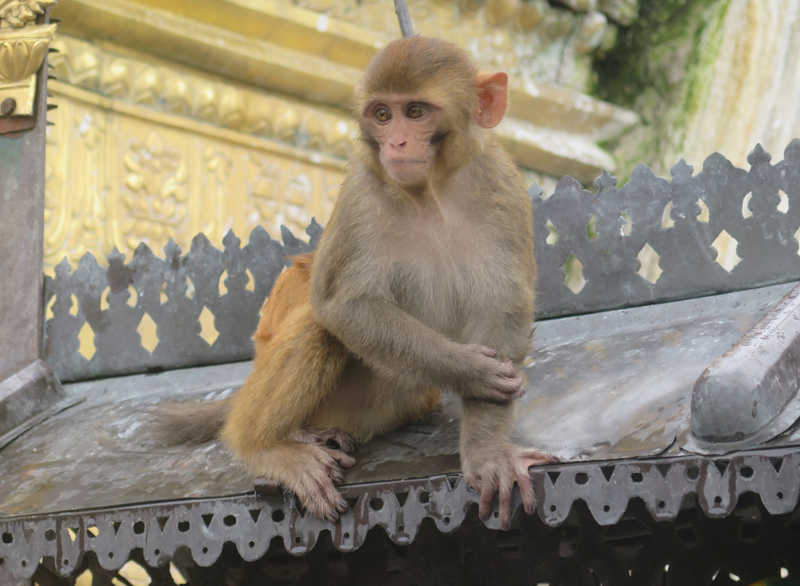
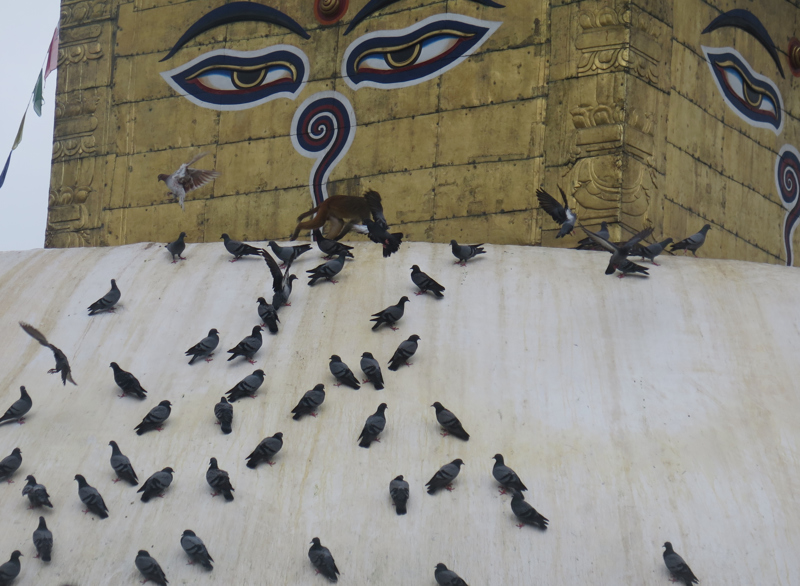
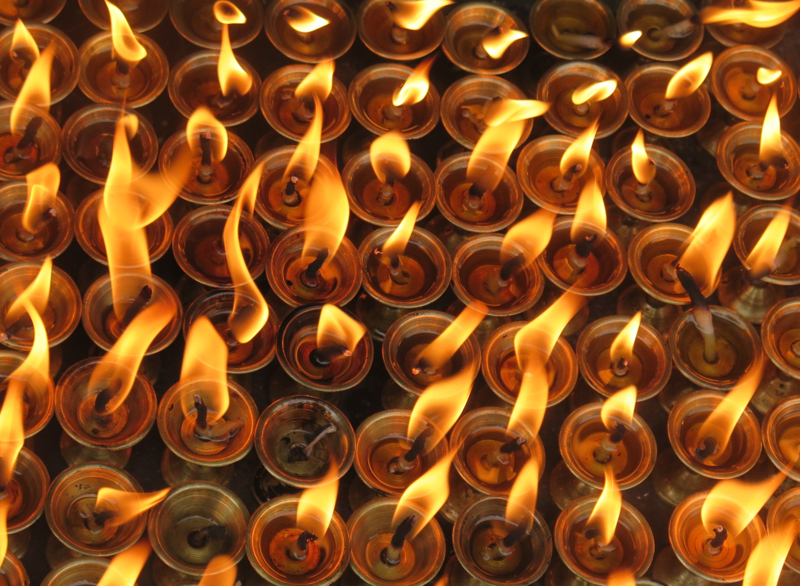


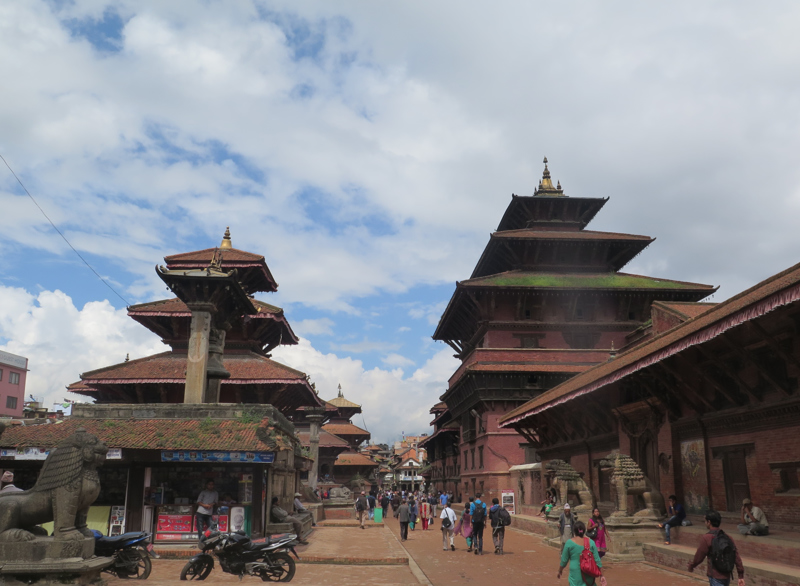

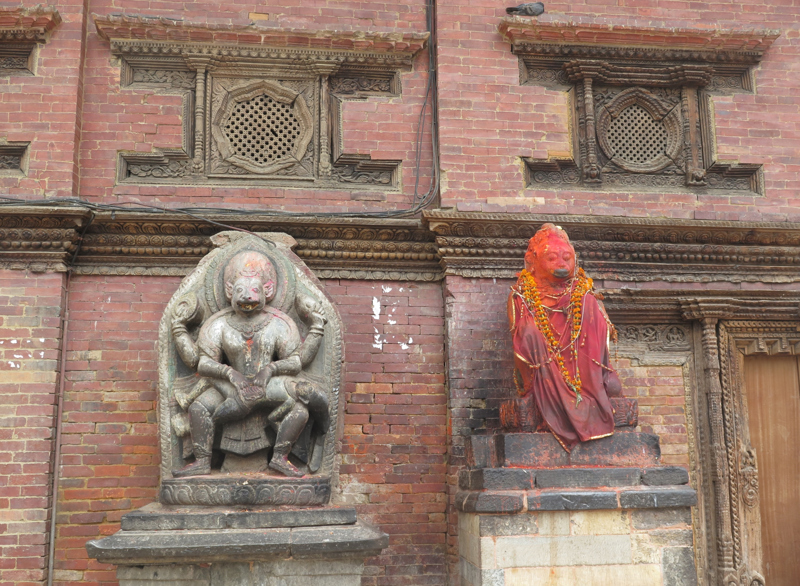
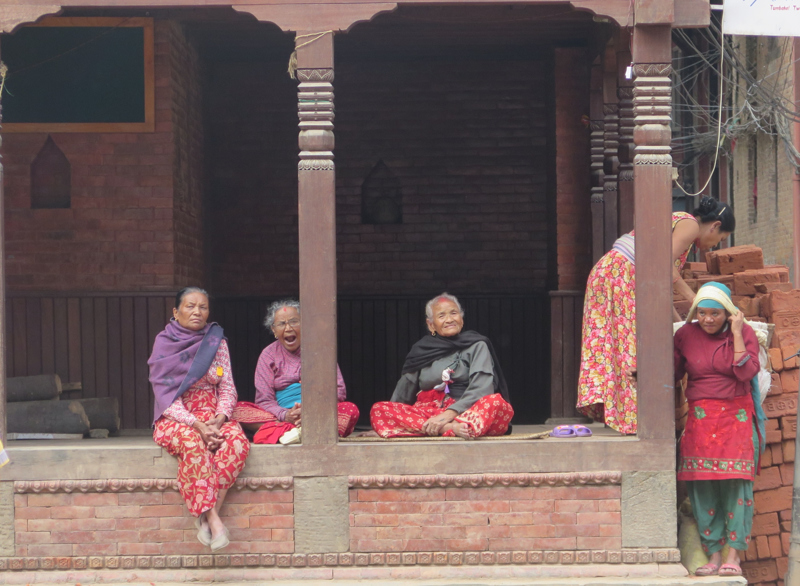
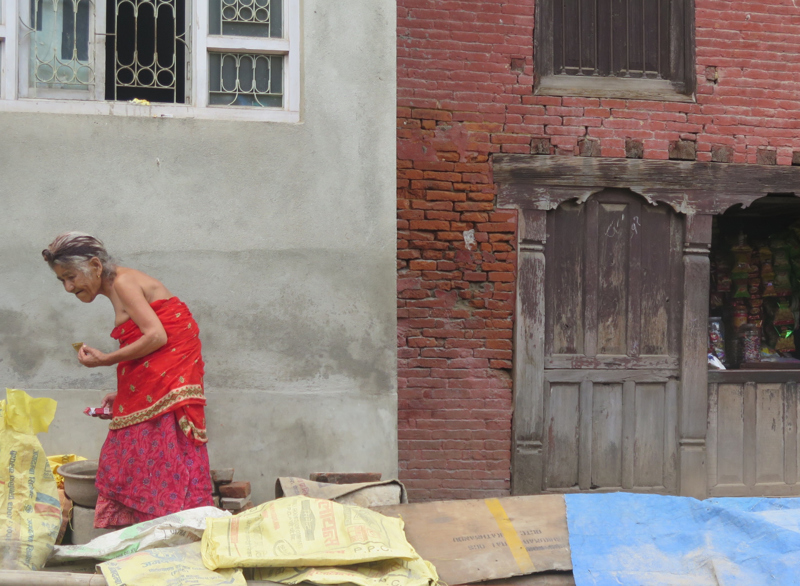
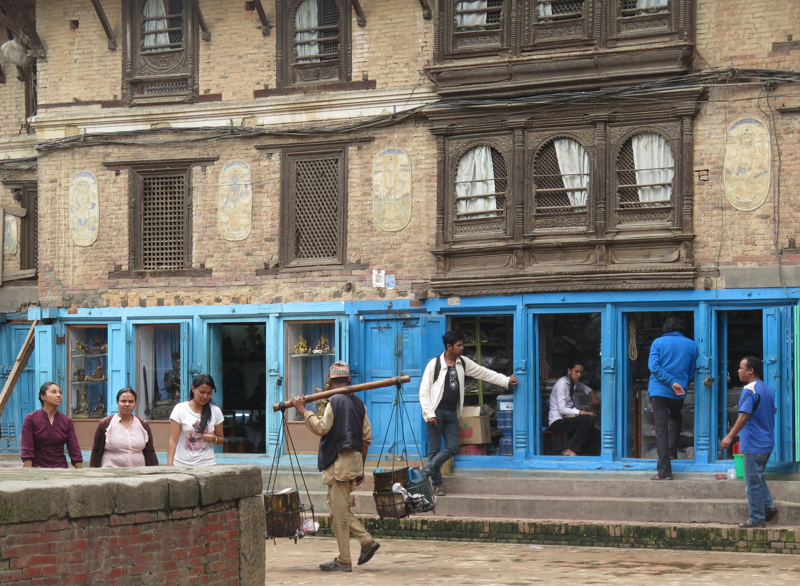
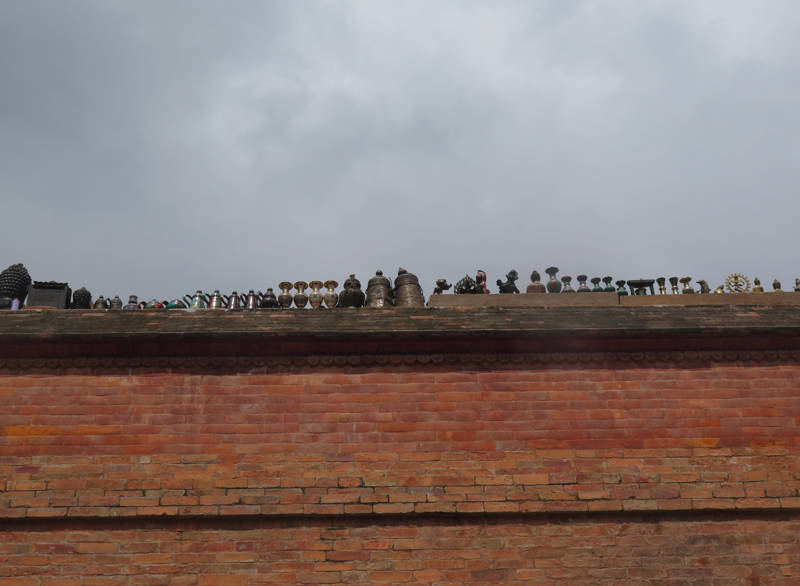
structures. The roof of one building is held up by strips of timber, sculpted into a goddess with multiple arms. The wooden window shutters have ornately carved diamond shaped grating. We leave the square and wander through the suburban backstreets of Patan. Intricately carved wooden banisters front the thin balconies, some broken and crumbling. Worn stone paving lies beneath our feet. The rubbish, dirt and narrowness of the alleyways conjures up my imaginings of a medieval Britain. The elders of Patan sit on steps chattering. Women carry woven baskets filled with heavy bricks into buildings for construction. Little squares and temples pop up around corners. Flags hang amongst the black tangled electrical wires above.
The Buddhist temple Boudhanath is the largest stupa in Asia. Its round white body, yellowing now with age, is covered with pigeons that take flight in flock sporadically. We eat lunch here in a restaurant overlooking the square. As expected in a restaurant in such a perfect tourist spot, the food is overpriced and mediocre. We walk around the stupa beneath the flapping flags of colour draped to the corners beneath a cornflower blue sky.
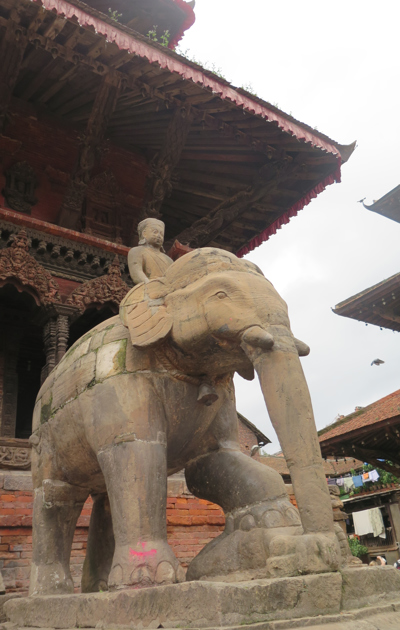
Our last stop is Pashupatinatl. Outside the temple, yaks embodying a Hindu god wander around. This Hindu temple is not open to those not practising the faith so we cannot enter. It sits next to the river. On the further side is a long stretch of stone steps and small stone structures with little enclaves, in which sit sadhus wearing their brightly coloured orange robes, their faces painted white and orange and their grey locks and beards flowing long. We cross the stone bridge to this side, a vantage point to watch the funerals taking place in this most holy of places. A family is carrying their relative on a wooden stretcher, the body of the deceased wrapped in orange robes. They take his body down the steps to the river to wash. His wife must remove all her jewellery given to her in marriage and the red paint drawn from the top of her forehead through her centre parting, which signifies a married woman. She sits on a wall crying after this
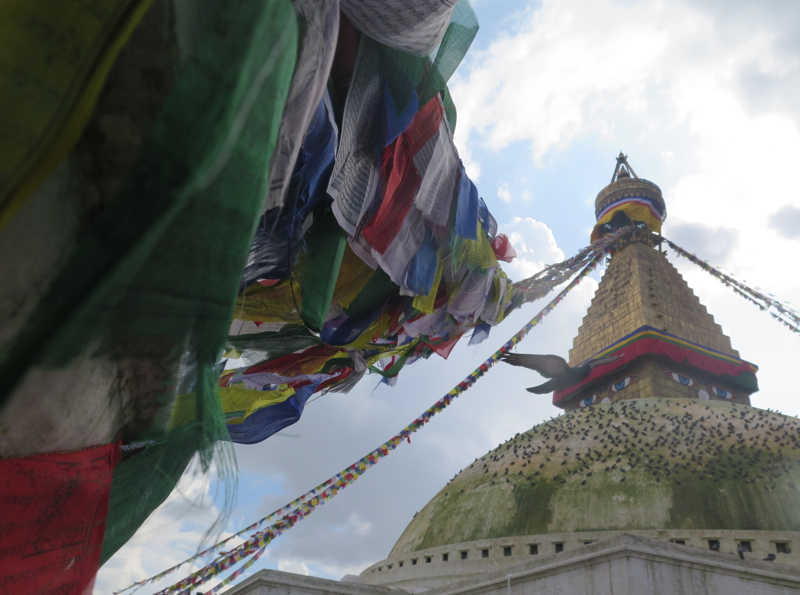
emotional ordeal. They carry the body covered in orange flowers to one of the wooden pyres further up the river, where after a short ceremony, it is set alight. Two pyres from funerals earlier in the day are already burning. On our side, children are filling plastic vessels with the same water into which the ash is swept, from taps near the river's edge.
In the evening we eat in a Tibetan restaurant in Thamel. The chilli momos here are delicious.
23rd September 14
It's a seven hour bus journey to Pokhara. I sleep through much of it.
We pass majestic, green, luscious mountains. Paddy fields lie in the valleys, a wide river the colour of weak milk tea passes through its
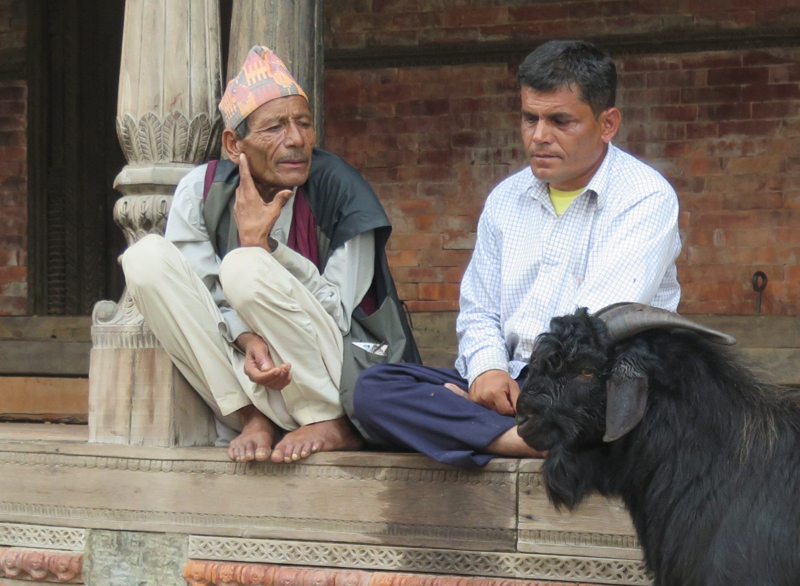
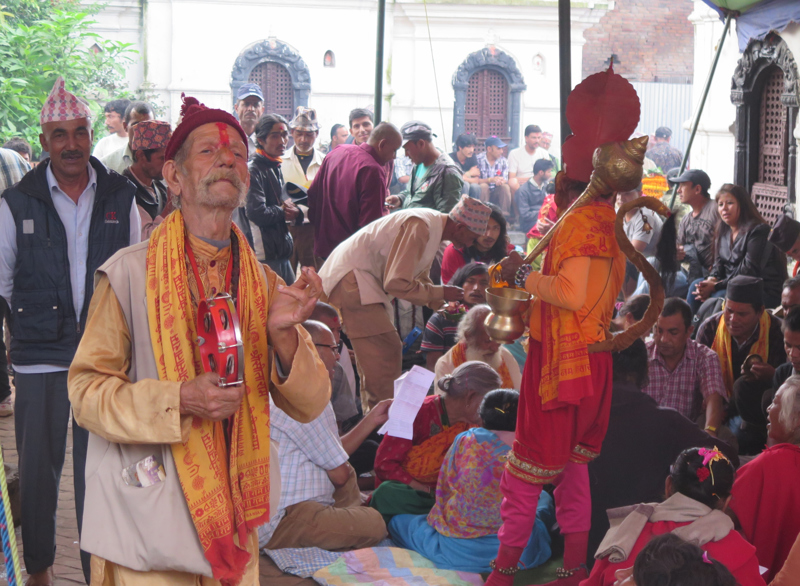

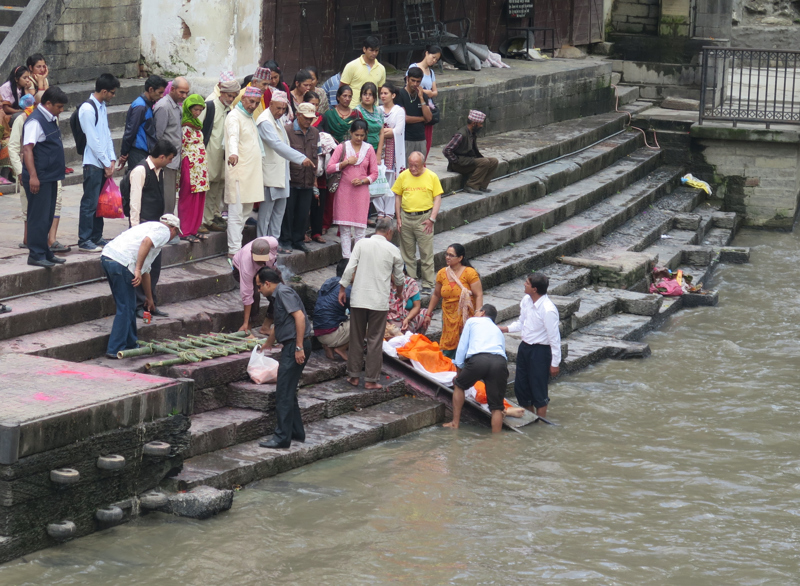
centre. White feathery long grasses grow in large clumps amongst the rice, like wisps of cloud laid out on the valley bed. Further along the river, cliffs soar steeply on the opposite side. We pass through small settlements. Buildings are roofed with square slates placed in diamond shapes or corrugated iron kept in place by small rocks balanced on top. Brightly coloured clothes hang in lines like prayer flags. Red flowers are planted in little garden plots at the front of the houses. Plains of paddy fields and corn, illuminated yellow and green in the sunshine lie behind the houses. Hay is stacked in conical shapes in the fields.
As we near Pokhara, the buildings we pass are simple, but a hodge podge of differing styles. A few ugly blue glass fronted buildings, the glass cut in large quadrilateral shapes. Some have crazy paving shaped stonework bordered with blue paint. Others are fronted with triangular Grecian fronts and bright painted columns, but most are built from thin bricks, both grey and white, laid in stripes. Ornate cylindrical banisters line balconies on wealthier houses. Houses are painted in a variety of eclectic colours: fluorescent orange, peach, mint green, pale yellow, garish pink, cornflower blue. A bridge is broken across a river, a new one is being built. Along the main road as we enter Pokhara, there is a line of large advertisement boards.
We arrive in the afternoon and meet our new guide Nahren. He's a little ill-prepared as he's only just been told he is to guide us. His hiking gear has been left in Kathmandu so he is wearing pin-striped brown trousers and a normal pair of trainers. After a welcome masala chai in the guesthouse lobby, he shows us the way to Phewa Lake. It's a large lake, surrounded by lush, green mountains. Its waters are a murky green, which reflects the faint sunlight in a yellow ochre glow. Brightly painted blue and red boats are moored in pretty patterns at the shore, some as the petals for half a flower. We take a boat out across the water, Sophie rowing initially with the one oar provided, and later explaining the technique to each of us to row in a straight line. On the other side of the lake directly opposite us is a large landslide that occurred only a month earlier and sadly, destroyed settlements in its wake. We row past the small temple in the middle of the lake back to the shore. After Tim's initial scepticism to board this unstable wooden boat, I think he secretly enjoys the rowing. There's a bar offering Happy Hour overlooking the lake from its rooftop. We stop here for a few beers appreciating the vista.
24th September 14
The trek starts at Nayapul through a Mepakese village, along slabs of stone laid as a path between the quaint low stone houses, either with a corrugated metal roof or square pieces of slate. Many are painted

white with bright blue. The villagers are disinterested by our presence. There must be such a constant stream of tourists passing through their village. One local girl sitting on the pavement is busy taking a 'selfie' of herself, her 2 fingers making the peace sign. After an hour trekking we stop for lunch in a little restaurant and eat Dal Bhat. The houses, stone walls and vegetation are almost identical to that in the Welsh countryside.
It's short trek today, which takes 3 hours. The path leads us alongside a gushing waterfall through the luscious valley. Bright thin terraces of rice paddies and tall green trees grow on the opposite side. The white water in the pool below us where we stop to rest bubbles like boiling milk. Our guide is incredibly chirpy and upbeat, bubbling with energy. He poses for a picture with his umbrella and his bright yellow t-shirt, the colour matching his personality. He has shortened my name to Ali from Alice (my first name which was written on the form) - I don't have the heart to tell him that my name is actually Amelia. He's been guiding for a long time and he does everything he can to ensure our comfort and to look after us. He sends the porter on in front to secure the best rooms in the guesthouse, next to the western toilet with a view from the balcony. The guesthouse is a simple wooden building painted blue, the rooms bare with wooden beds and simple wooden bedside tables, but there's blankets, electricity and hot showers, all of which totally surpasses my
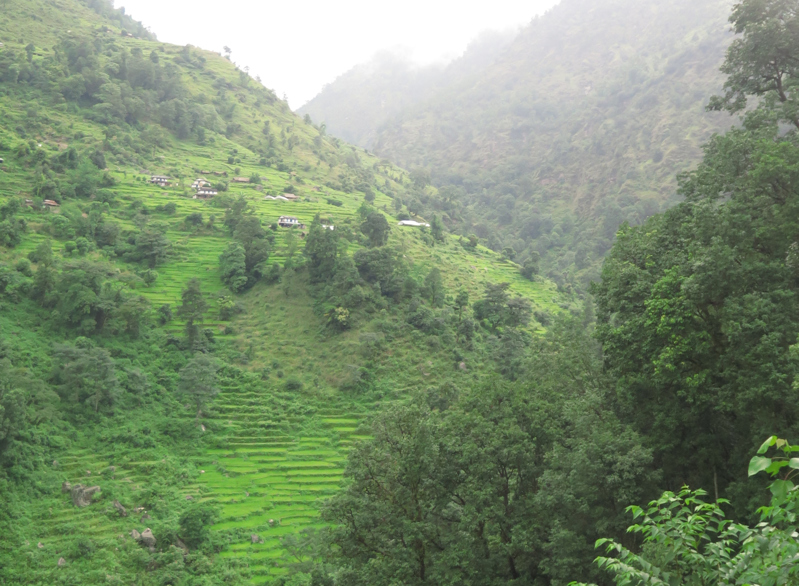
expectations. We drink masala chai and play cards until dinner.
25th September 14
Today we start the uphill climb from Tikhedhunga to Ghorepani. There are approximately 3,300 steps, so we view the coming day with apprehension. Our guide insists we order two breakfasts to provide the necessary energy required.
We cross the wobbly suspension bridge at the beginning of the walk over a rushing waterfall, the pool below the colour of mojito, and begin the climb up the seemingly never-ending stone steps. The sky is overcast, but the clouds are high enough that the immediate mountains behind are still visible. Rain is intermittent. Raincoats are put on and then discarded in a constant cycle. Nevertheless, we are thankful to escape the blaring sun.
Dashain festival is close approaching and as it is the custom to sacrifice a goat, it is now the time for the goat herders to bring their livestock down the mountain to be sold. Herds block the path streaming sure footed down the stone steps as we are cramped into the side of the mountain awaiting the final goat to pass before continuing on our way. Each herd we meet are grouped by the colour painted on their horns. The first in sunshine yellow, the next in brick
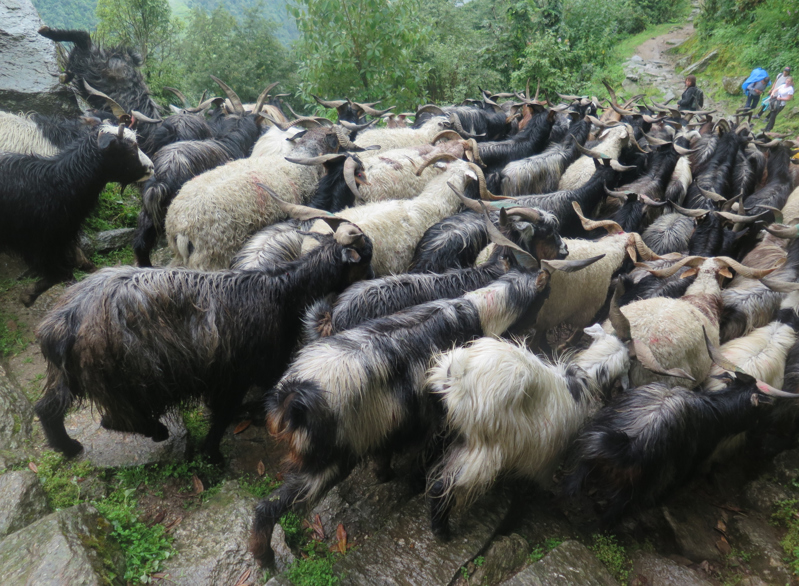
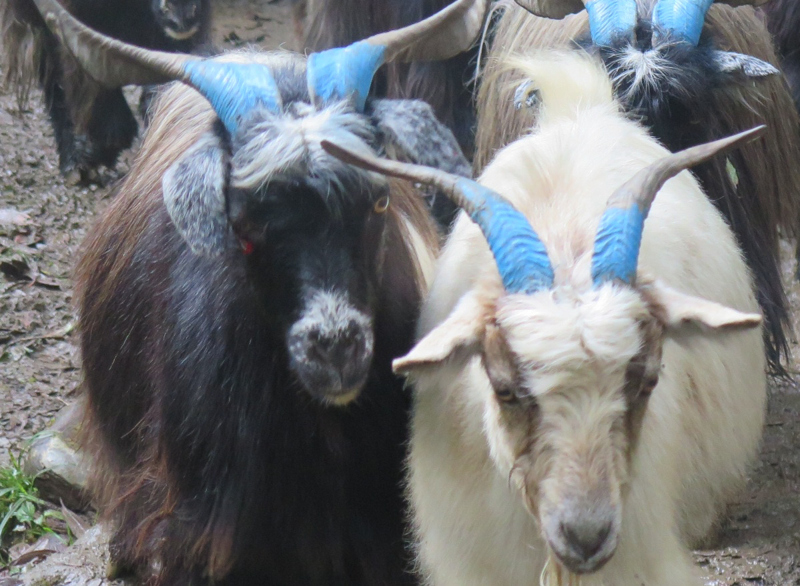

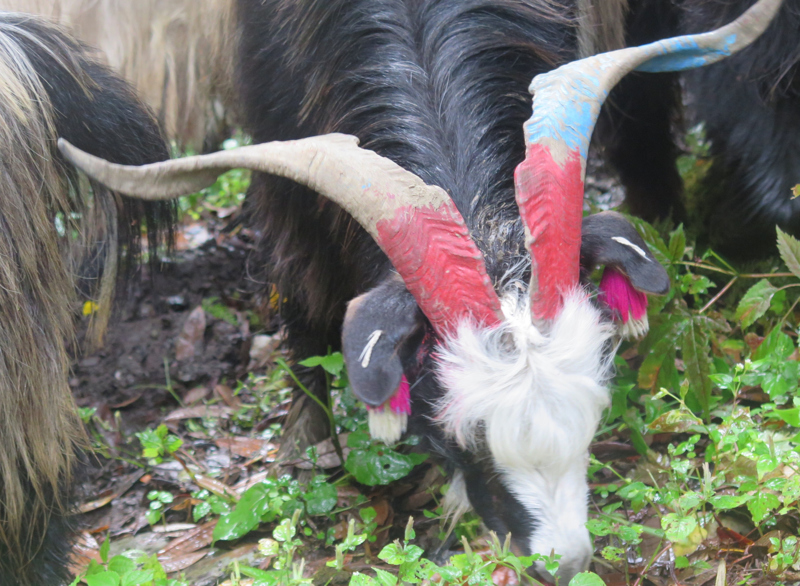
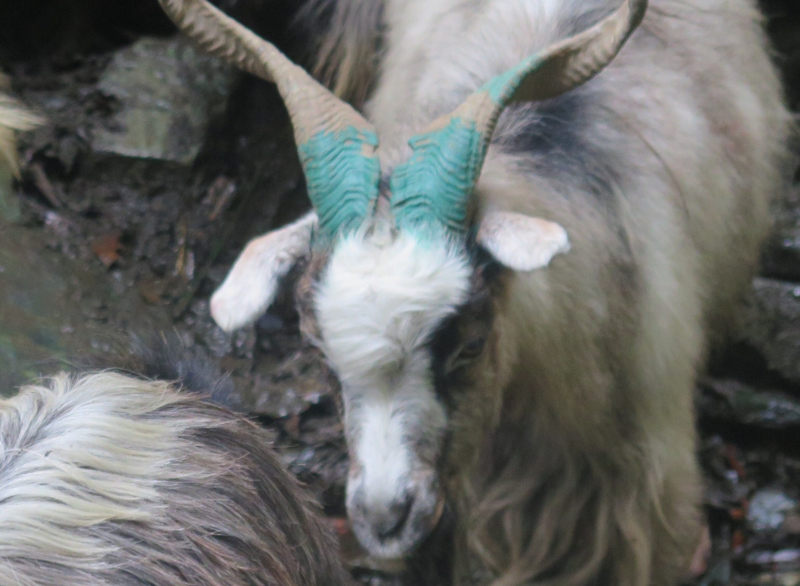
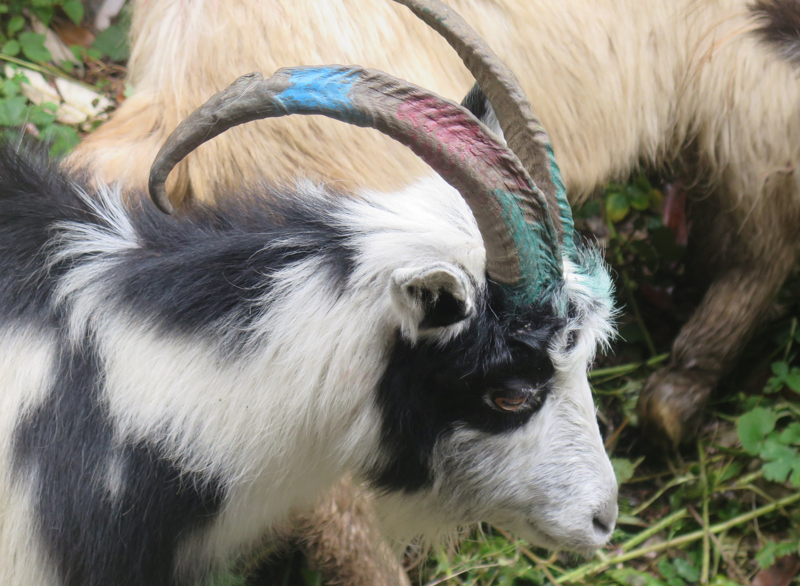
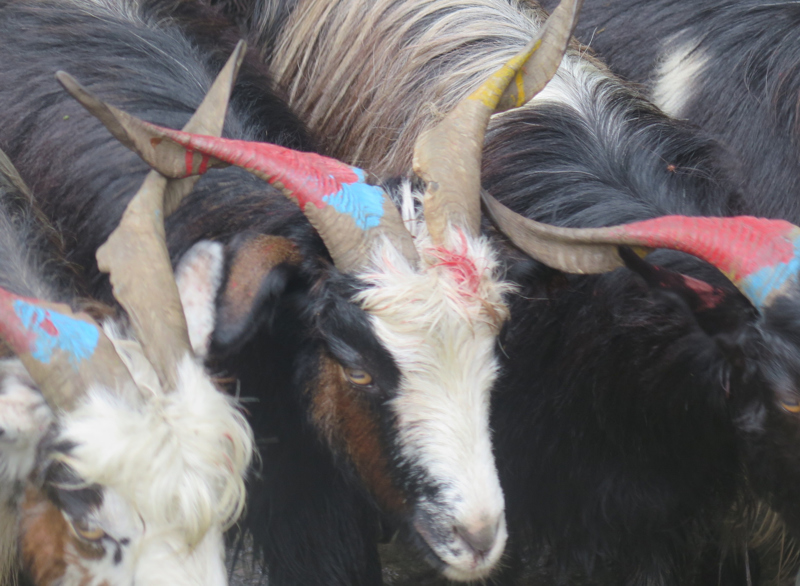

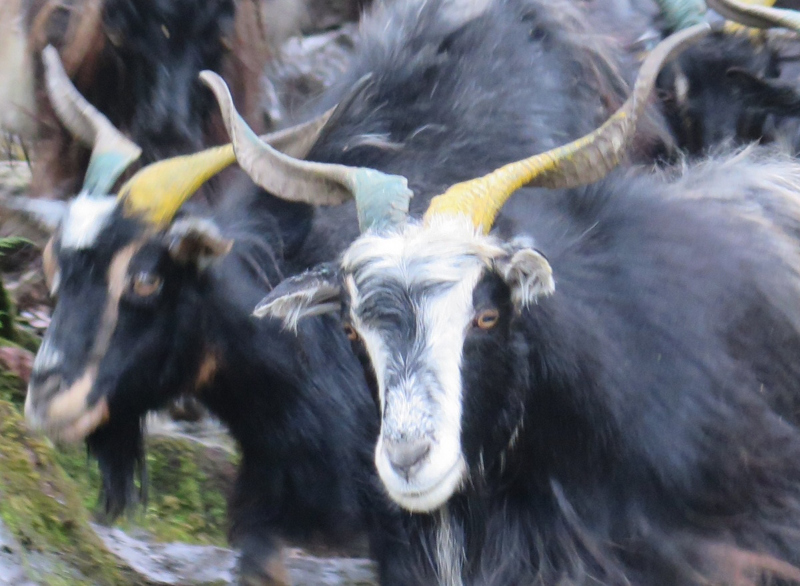
red, mint green, sky blue, one herd a mixture of the 3 primary colours: red and blue on the right horn, the left in yellow. In the opposite direction, packs of mules carry provisions to the teahouses and villages above.
In the afternoon, we pass through a wooded area of red twirling branches coated in moss. It's been an exhausting climb and it is with relief that we reach the guesthouse. The stone paths and slate roofs and the overall bleakness beneath the overcast sky at dusk reminds me of the Welsh moors and surrounding villages of my grandfather's holiday cottage we visited when I was young. The sky is darkening shortly after we arrive. It's cold up here and we are thankful of the wooden fire burning in the centre of the tea house.
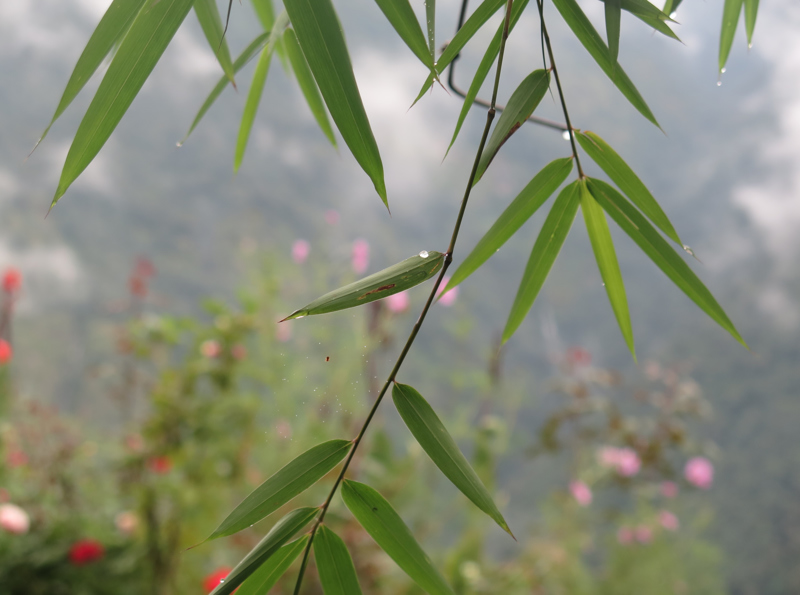
26th September 14
We rise at 4.30 to catch the sunrise at the top of Poon Hill. It takes about an hour to climb to the top. I wait halfway for Hannah. The sky is disappointingly overcast so the previous night's promise of a beautiful sunrise and panoramic view seems unlikely. The porter is with Hannah and when they stop to rest, he lays his head on the stone, his breathing rapid. He's clearly not well, and having accepted water and paracetamol, refuses to give up. We insist that he goes back down now and a kind man, also on his way down with his wife, offers to escort him safely back.
Poon Hill is at a height of 3210, not high enough to really be affected by the altitude. When Hannah and I arrive, to our surprise and excitement, Sophie and Tim have just got engaged at the top of the hill! Disappointingly the view is totally smothered by mist and there are lots of people here, but Tim found a perfect, tranquil spot amongst the pretty thistles, yellow flowers and prayer flags draped amongst the bushes, to propose. We take photos of the happy couple in the same spot, although they refuse to reenact the actual event for us, their paparazzi. I'm thrilled and honoured to be a part of this magical moment in their lives.
I eat a breakfast of porridge and Tibetan bread and pack to leave. Outside the teahouse, snow
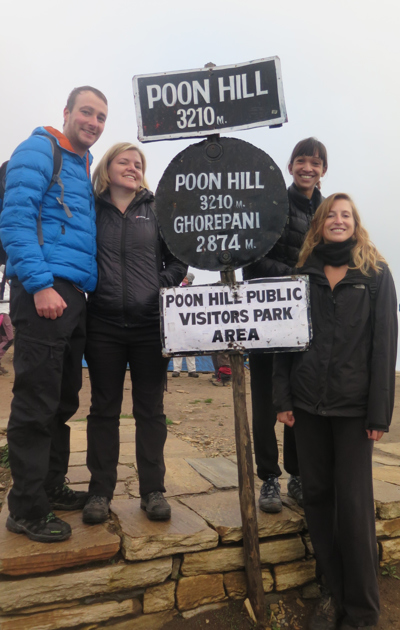
capped peaks are rising through the clouds which are slowly beginning to dissipate, providing us with a glimpse of the fishtail range we had missed from the top of the hill. We walk upwards again, through a pretty woodland. Three seemingly wild ponies are grazing within this magical setting. One of their coats is as white as a unicorn. A spotlight of sunshine shoots through delicate, moss covered tree trunks onto a floor of bracken. We tread over swirling roots out onto a meadow of wild flowers in yellow and purple and long grasses. Thabala hill is at 3165 metres. Thistles and cow parsley brightens the mist filled landscape. The white tip of a distant mountain is visible briefly before the cloud sweeps in to engulf it.
From here, it is a long descent. The path follows the valley next to a raging river broken up by waterfalls. A vertical wall of rock rises on the opposite side. The mineral in the rocks shines iridescent in the
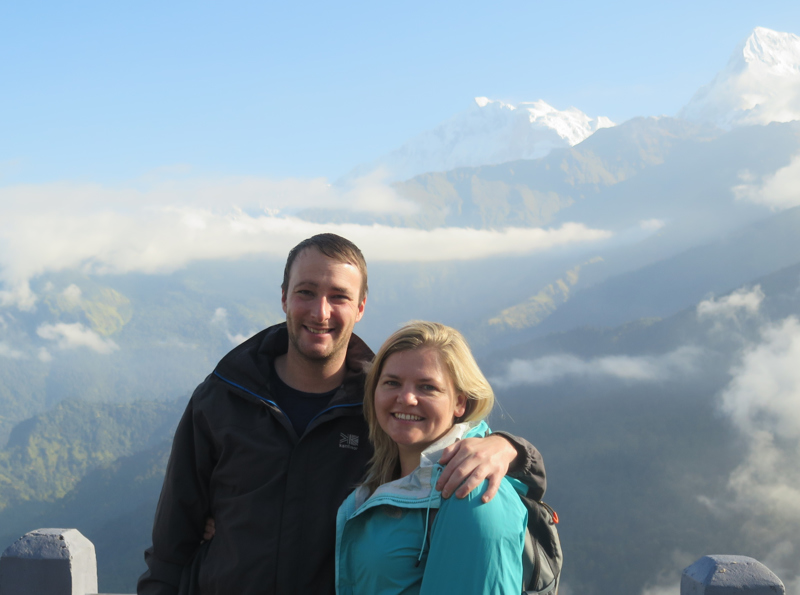
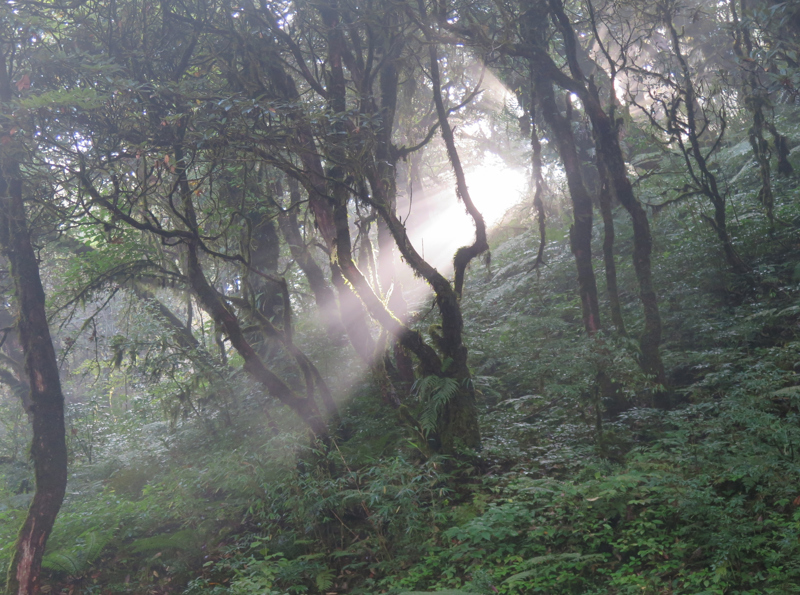

sunlight - it's as if the steps are plated in silver. As we leave the river behind, we pass through a beautiful jungle of gnarled mossy trees, the bark red in colour and wooded floors emerald green, reminiscent of the landscape conjured up in The Lord of the Rings. Little purple Himalayan flowers grow in the cracks of the stone steps coated in moss. The path leaves the forest canopy opening onto a view of majestic mountains coated in green treetops, like bouncy clumps of moss at this distance, which continues into the valley far below and mountains behind. The sun is shining and we sit to admire the view, waiting as a herd of goats pass by. Within minutes, the cold mist has seeped across our line of vision and hidden the panorama behind a wall of white in front of our noses. Only the little yellow flowers at the side of the path are now visible. We enter back into the enchanting green world of curling trees and dappled sunlight. As we come out again into the open, drops of rain are pattering on our heads. The sun is shining behind us and ahead is the perfect arch of a brightly
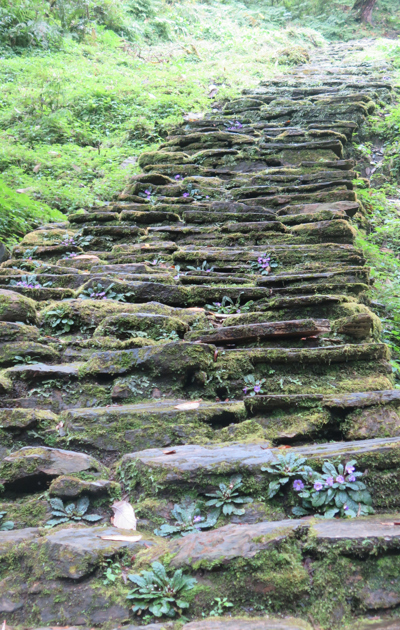
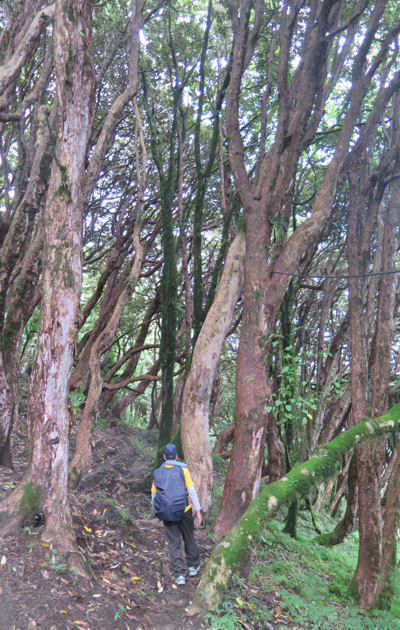
covered rainbow. It's still another hour down more stone steps, past kitchen gardens, cabbages and cucumbers growing in abundance.
Eventually we arrive in Tadapani. The quaint guesthouse we are staying in is stone painted white, with wooden cornflower blue balconies. Corn is drying all along the verandah. There is an incredible view from our balcony where we sit with our masala chai. Dark green mountains fade in colour into the distance in the late afternoon light. The snow capped peaks beyond shine almost golden in the sunset, their tops just below the line of mist.
In the evening after dinner, I join the family and another guide in shelling beans. It's therapeutic work and I sit there for an hour before bed, chatting and smiling. Everybody is laughing before I head upstairs as I said I would only shell a few.
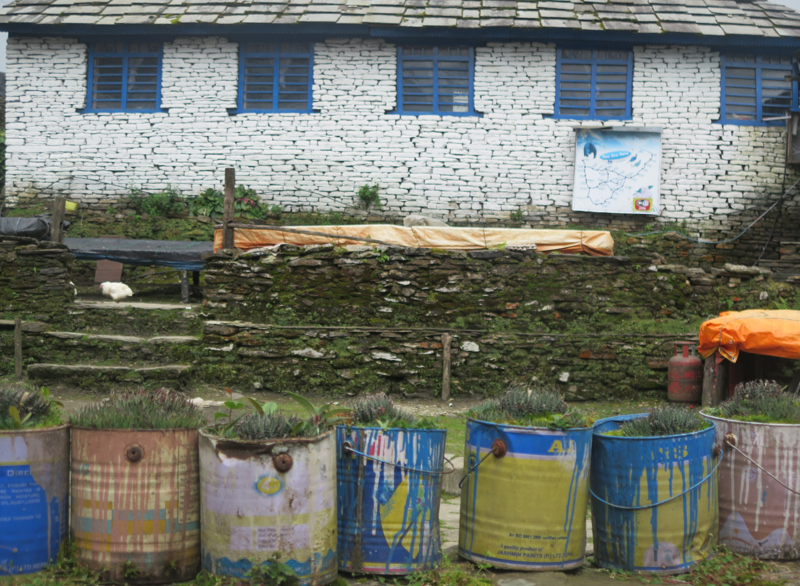


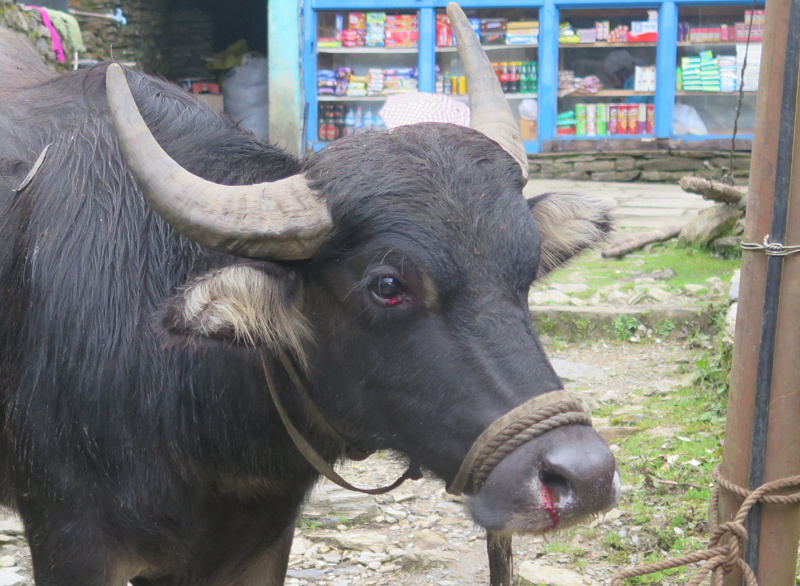
27th September 14
Today the sky is postcard blue and the view from the guesthouse spectacular. It's our final day trekking, downhill back to the start point. Along the path, rice paddies glow lime green in the sunlight. Small settlements sit in the vast mountainside opposite us. Undulating terraces pattern the mountain in wavy stripes. Waterfalls gush in powerful streams in the distance. The river flows through the valley as we make our way down to meet it. Mules continuously block our path carrying their heavy loads. Large rusting bronze bells sit beneath their necks signalling their approach. Some are decorated with colourful headdresses, diamond shaped pieces of carpet set between their eyes in patterns of reds, pinks, yellows and green, with strands of colourful material draped on one side of their heads. Pretty
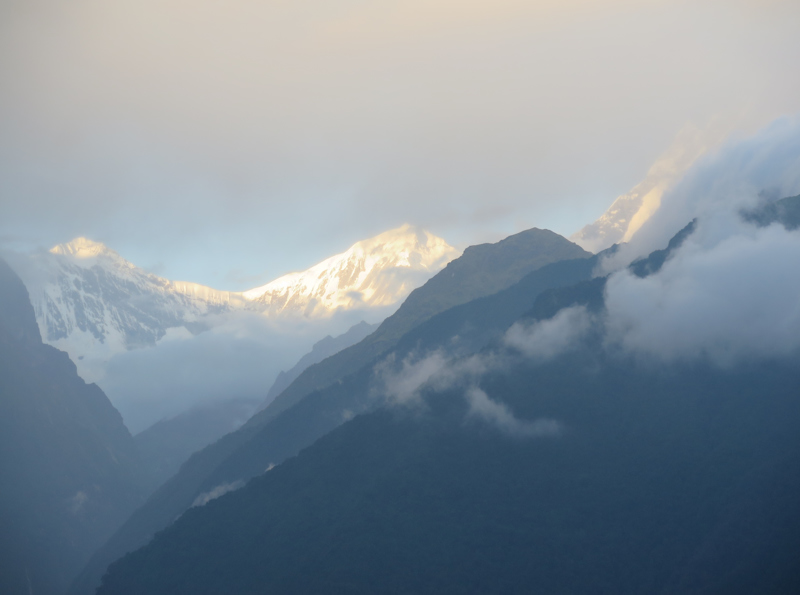
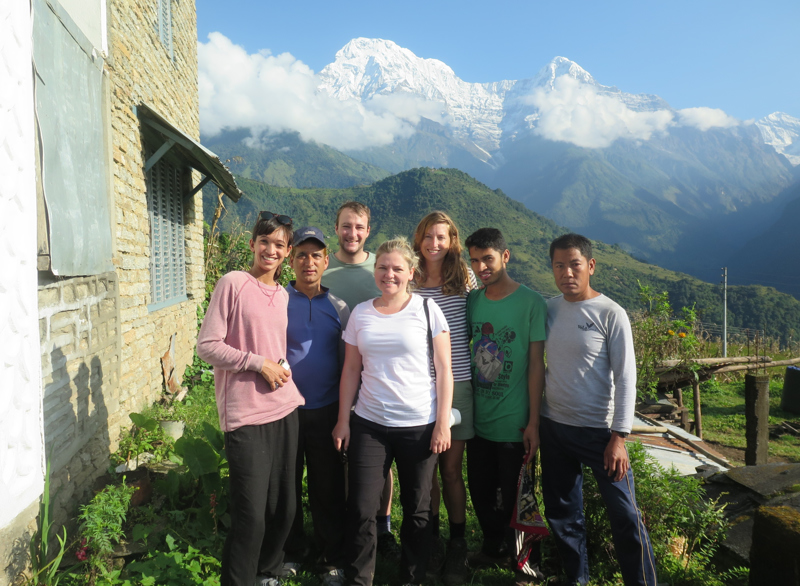
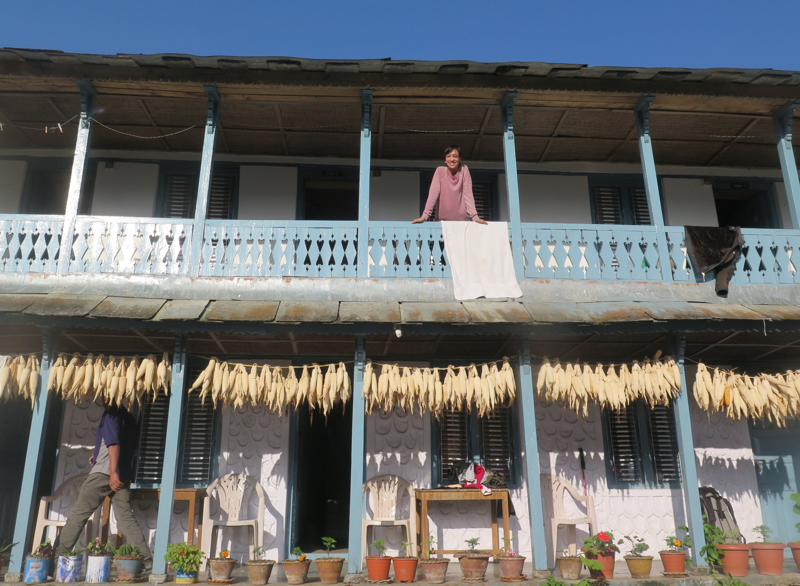
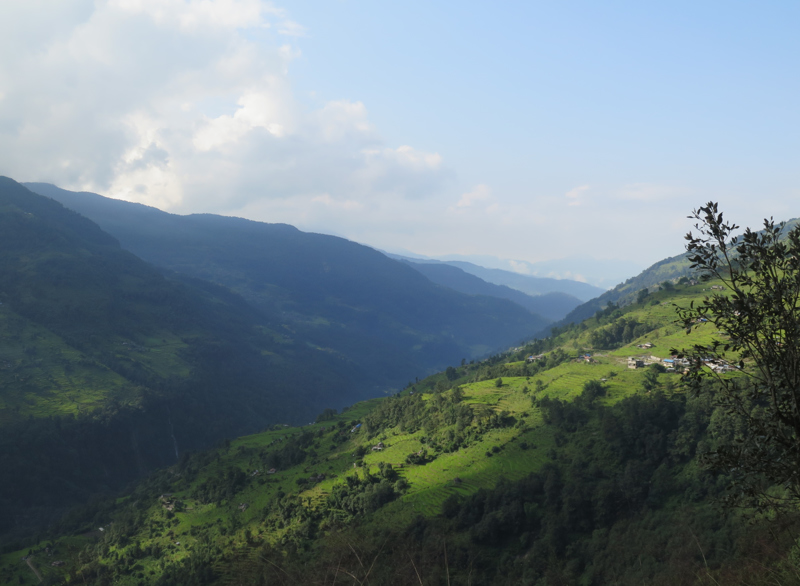

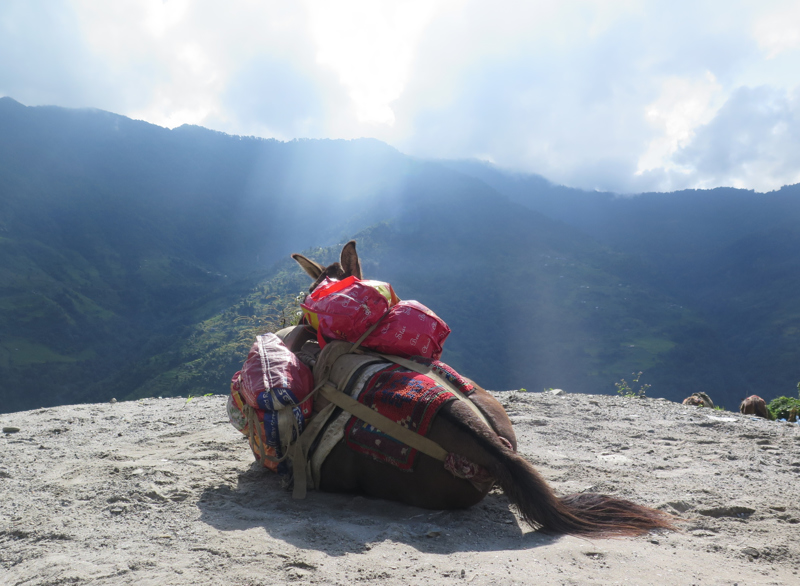
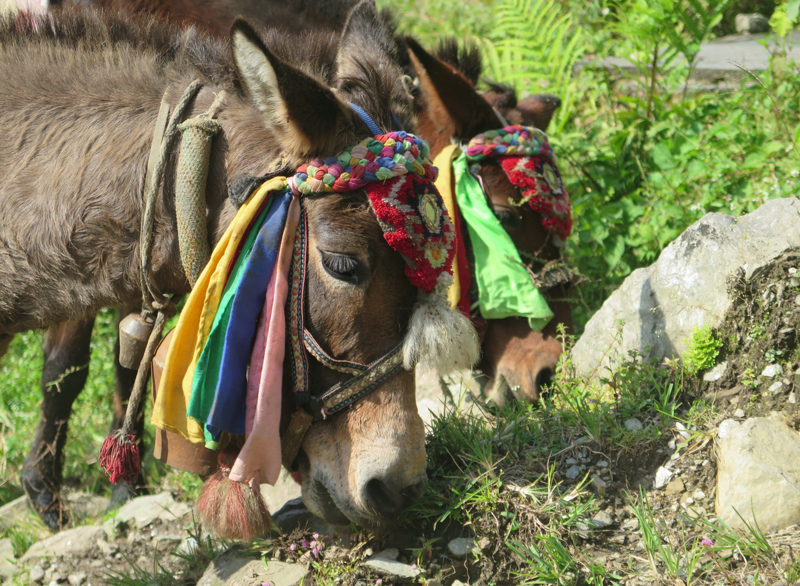

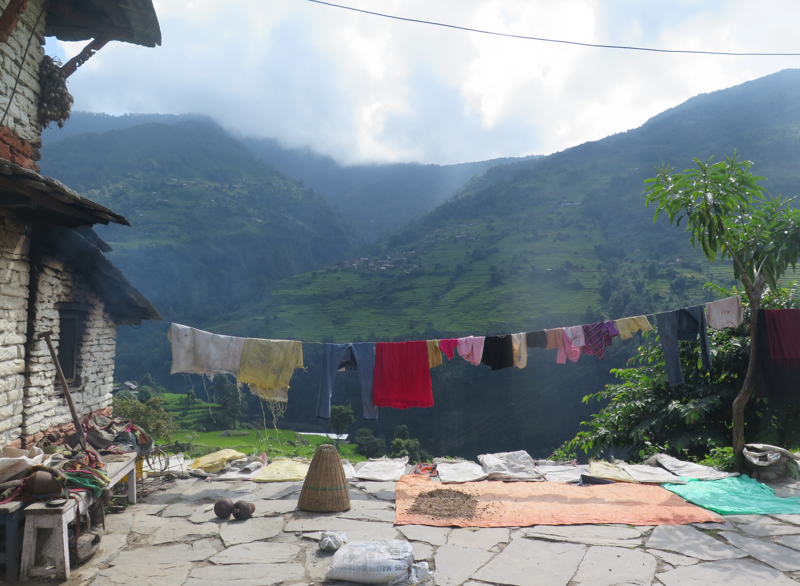
small carpets sit on their backs beneath their burdens. Shush sounds and a wooden stick are used by the herders to keep them in line. As we draw near Ghandruk village, a lady runs at breakneck speed down the mountain behind us, shouting loudly and angrily, passing us and continuing on her way. Our guide, after chatting to the villagers, tells us she is unhinged. We ask him what she is saying. He says it's difficult to translate as he heard a jumble of nonsensical repeated sentences, but it sounds like she is furious with a woman. Snippets of 'you killed him' and something about 'my brother's children' are discerned.
An enormous swing has been built on the mountainside from bamboo, apparently part of the Dashain festival, and a group of children are happily playing here. We pass villagers dressed in smart colourful clothing sitting on the floor outside a hut singing. It's a Sunday and we understand this is their church as they practice Christianity here. As we reach the river, we stop in a restaurant to buy water. There has been a landslide just a few metres away from the restaurant. Where now weeds grow amongst the slippery rocks, only a month ago were perfect lines of terraced paddies. The path is completely submersed beneath the fallen stones. An orange digger is working to clear the debris.
It's now just a 2 hour walk back along the bumpy road which is completely flat - a relief for our aching muscles. We stop for lunch in Nayapul, eating chicken spring rolls and chips. From the restaurant balcony, there's a picturesque view overlooking the fast flowing water and fishermen fishing with their rods.
We arrive back in Pokhara in the late afternoon and head out to celebrate the engagement! In the Main Street in town, a stage has been set up with Nepali music. Here, a few dancers spinning in circles are dressed in gold headdresses with peacock feathers sticking high above their heads. Tim is on the lookout for a pub, and we soon locate a typical 'Irish' pub that you can find in most tourist destinations the world around. It's a large venue and happily for Tim, the football is on, but happily for me, the game is almost over. A Nepali cover band is playing - we hear Nirvana, Coldplay and Dire Straits. We find a rooftop restaurant for dinner. One of the worker's kids is running wild trying to keep himself entertained by jumping on low tables and swinging around a pole. He interacts with us, sharing his cement truck toy to play with and bringing us a pair of scissors. Tim makes him a snowflake from a napkin. He is amazed and after trying this himself, he keeps returning to cut out more patterns, while I turn the tissue to prevent him from cutting it completely in half and trying to save my fingers at the same time. We're all a little tipsy and totally exhausted after our 4 day hike. It's only 10.30 when we head back to the hotel for bed.
28th September 14
We wake early for a long bus journey to Chitwan National Park in the south of Nepal. The humidity and heat at this much lower altitude is in stark contrast to the crisp, dry air in the mountains. We are picked up by a safari bus and our guide on our arrival and escorted to a resort hotel of little concrete huts on stilts. The resort is fairly soulless but the rooms are spacious and clean and there's a

swimming pool (which I can't use due to the infection on my ankle).
We have a short time to rest before the tour begins. Our guide takes us first to visit the government kept elephants. Since the front two legs of these majestic, powerful animals are kept in chains, it's an unpleasant experience. We walk along the path on the bank of the river to see the sunset. It's so populated with tourists here that it feels like we're walking along the Thames tow path. The sun is setting in a pink glow reflecting upon the tranquil river. Feathery white grasses grow on the further bank. Our guide points out birds and deer amongst the long grasses in the line of the trees in the distant . A pescetarian crocodile is lounging in the mud at the river's edge, its mouth a bizarre long-nosed snout. It sits so still that it almost looks like someone has planted a plastic model of a crocodile to please the tourists.
We decide to forgo the traditional dancing this evening. It's been a hectic week so far and we'd prefer to relax and chat over dinner. There is a conference taking place at the hotel and the dining room is overrun with World Vision employees, so we sit outside. The tables are round with maroon cloths and the chairs are covered and tied with ribbon as if for a wedding.
This evening we have a discussion regarding how we feel about riding an elephant. None of us would have chosen to, but it is covered within our tour cost

and we come to a conclusion after much deliberation and debate surrounding the ethics of domesticated and working animals and the fact that none of us are vegetarian, that we'll ride an elephant tomorrow.
29th September 14
There is a small wooden stage with four legs and a surrounding railing, which the four of us squeeze into with much difficulty facing back to back looking out over the corners. Our elephant trundles through the jungle undergrowth. Tim and I are facing the elephant's behind so are oblivious to the treatment of the elephant by the old man guiding him. According to Sophie and Hannah, the guide is pushing his feet against the elephant's ears to direct our path. We enter into the long grasses of the park and suddenly we hear the shout of 'rhino'! A rhino is trundling through the undergrowth in front of us and our guide is commanding our elephant to chase it. I catch a snap of its back as it disappears amongst the long grasses, but to our surprise and luck, it stops in a clearing, where there a second rhino appears. The elephant sits here while we snap away at the pair, hardly believing that we are seeing them at such a close proximity and slightly wary of our lethargic elephant's defence abilities against attack. 3 white birds settle on the back of one rhino. Their small, vicious horns stick up above their noses and their ears are almost rabbit-like. Their grey plates of armour are mottled with large bumpy spots and their necks layered in wrinkles. From here we have a perfect view for pictures as they amble aimlessly nearby. Suddenly one starts to chase the other and they charge towards us. We sense fear in the elephant beneath us as he attempts to back away, but to our relief they circle around us and disappear back into the long grasses from where loud grunts are emitted. We assume they are mating.


In the afternoon we take a leisurely boat ride along the river, in a long, roughly chiselled canoe on little wooden chair-like structures sat on the floor. On the bank directly opposite lies a crocodile, its mouth wide open ready to catch its prey. It's ever so peaceful as we flow with the current. The waters are infested with crocodiles. Our guide points them out as we glide down past – some with their heads poking out of the water, some with their bodies covered beneath mud and others sunbathing on the stony banks. Flashes of iridescent blue and orange in the form of tiny kingfishers are pointed out along the banks along with other birds. Our guide lifts his precious bird book above his head to indicate each specie. He's so passionate about his subject - the epitome of a typical geeky bird watcher.
We embark from the boat for a walk through the national park. Our
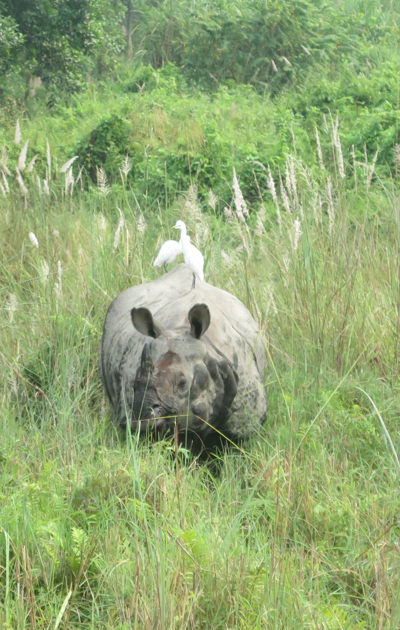

guide is relieved we have already seen rhinos this morning as it removes the pressure to locate one for us now. Instead, he sites spotted 'Bambi' deer, boars, peacocks, wild chickens and other birds and passes around his binoculars. He locates a fresh tigers paw on the ground, but we are not fortunate enough to see this animal, although we are unsure whether we would want to while on foot, with no protection. We've already read in the guidebook how to react to different dangerous animals, but thankfully we're not required to put any of these techniques into action.
30th September 14
We catch the bus back to Kathmandu this morning. The road follows the river along the mountainside. 2 rivers join together and here the channel is split down the middle in 2 separate colours like chocolate and vanilla ice cream, before churning together a little further downstream. Waterfalls streak down the side of the mountains. Leaves and grass at the side of the road are coloured grey, caked in the dust shot up by passing vehicles. There's a large 'Hollywood-esque' sign on the mountain opposite - an advertisement for Ncell. Passing through a settlement, there is a house of stone and slate with engraved timber, which is blackened with smoke and decaying, yet aesthetically pleasing. Men are sitting chattering, in a square porch like a bus stop. A large rock sits in the river bed below,
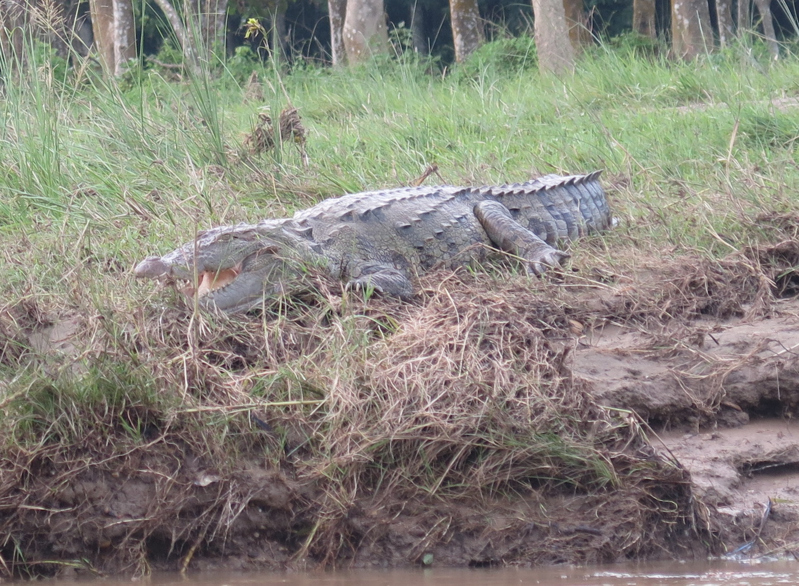
its back shaped like an elephant's behind. Goats are travelling into town in truck-fuls. 3 balance precariously atop a minibus. We reach the outskirts of Kathmandu. I notice a strange tall female mannequin with dark hair and sunglasses dressed in a patterned dress standing amongst the rubble at the side of the road. Trendy Nepali girls in skinny jeans cross the road.
The tour ends with a grand finale - dinner with a cultural show in a hall that seats every Earthbound group that has finished their tour today. We're served food in traditional brass plates, bowls and cups. I have suddenly become aware of my lack of budgeting and my money situation is dire, so I forgo an alcoholic drink this evening. Typical Nepali dancing is performed on stage while we eat the starters and the Thali. At the end of the evening, the band plays Resham Firiri, which we have been singing throughout the trip and which anyone
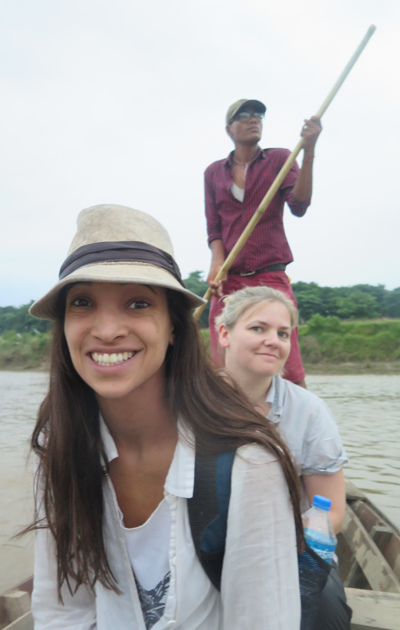
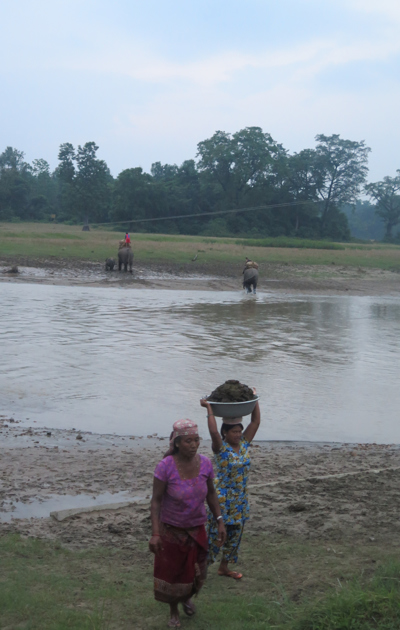
trekking in Nepal cannot escape hearing. 'Resham Firiri, Resham Firiri, sometimes trekking, sometimes rafting, Resham Firiri'. It is a slightly derogatory song towards porters, with silly verses such as 'I am the monkey, you are the donkey' - the tourist free to roam, the porter carrying the heavy burden of our possessions on his back. As for Resham Firiri, after asking different people for its definition, I conclude that it means 'silk blowing in the wind', possibly the material a trekker would wave if lost. We're pulled onto the stage to dance and along with the other women in the hall and one man, we all copy the dancer's moves. It's a great end to the tour. Back at the guesthouse before bed, we drink a beer with an Irish couple we chatted to on the trek. They're pretty funny and they share the awkward moments they experienced on their trek, with their guide sometimes being inappropriately tactile and making one woman in particular feel very uncomfortable. We tell them about our sweet, smiley porter who was very much taken with Hannah. Hannah nicknamed him Shadow, since, much to Hannah's annoyance, he didn't leave her shoulder for the entire trip, both while trekking and at dinner, and even shouting out her hand when we were playing cards.
1st October 14
Sophs and Tim are leaving today, but they have time for a morning coffee before their midday flight. We've just had breakfast but we order cakes all the same, which we unsurprisingly can't finish. It's been so nice to spend so much quality time with them. We're sad to say goodbye, but know it won't be all that long until we're all back in London together.
1.
Arrival in Jakarta, Pangandaran, Jogjakarta, Malang
2.
Volcanoes - Mt Semeru, Mt Bromo, Mt Ijen
3.
Ubud - a brief Sojourn
4.
Gilli Trawangan - white beaches and turquoise waters
5.
Boat Cruise - past the Komodo Dragons
6.
Flores - traditional villages and Mt Kelimutu
7.
Kuta, Lombok
8.
Baliem Valley - trekking in the mountains and meeting the Dani tribes
9.
Sentani - the festival and the lake
10.
Tana Toraja - Funerals and Burial Sites
11.
Kuala Lumpur - back in civilisation
12.
Cameron Highlands - trekking and tea plantations
13.
Georgetown, Penang - street art and crumbling mansions
14.
Banda Aceh and Pulau Weh - contending with Ramadan; Scuba Diving and snorkelling in paradise
15.
Lake Toba - the Batak people
16.
Bukit Lawang - Orangutans
17.
Unawatuna
18.
Volunteer Sri Lanka - Week 1
19.
Volunteer Sri Lanka Week 2
20.
Kandy and the East Coast
21.
Ella and Colombo
22.
Volunteer Sri Lanka - final week
23.
Earthbound Expedition - Kathmandu, Poon Hill and Chitwan National Park
24.
Back in Kathmandu
25.
Langtang - solo trekking
26.
Kathmandu to Varanasi